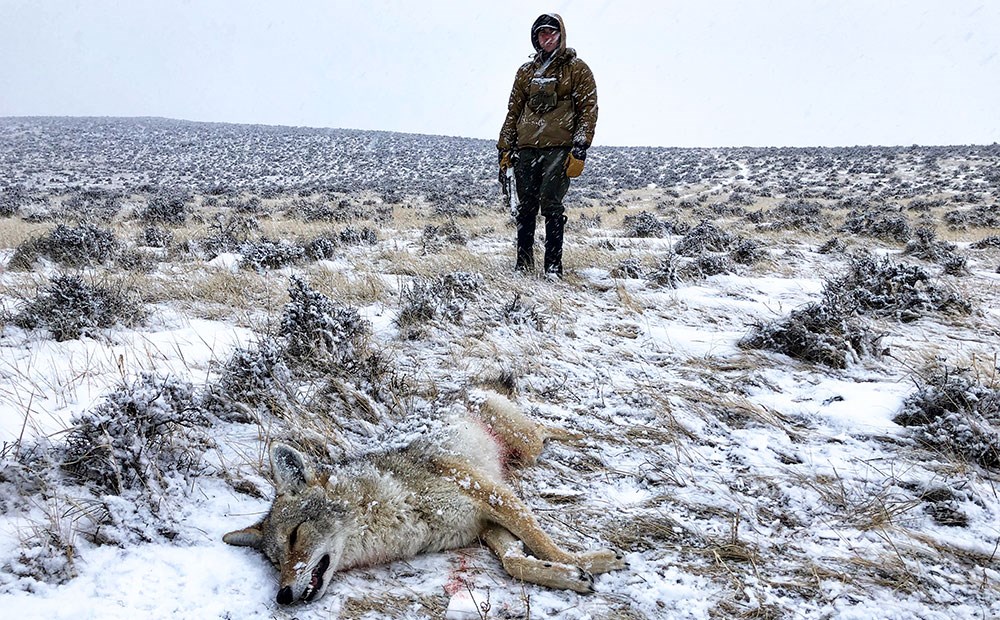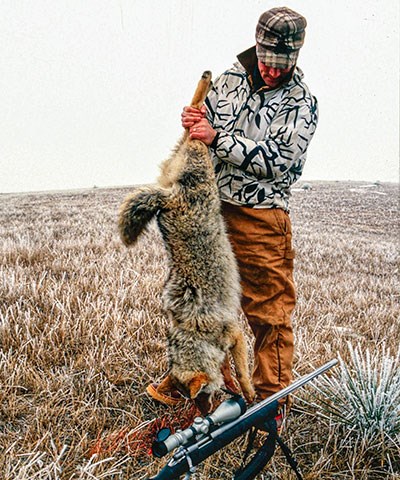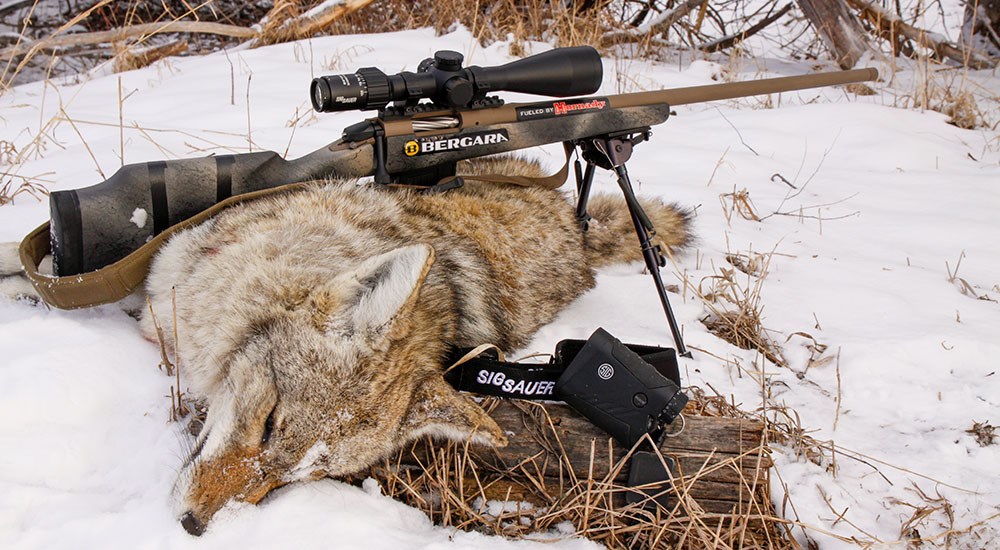
Criminals, enemies and even Hollywood villains all share something in common: they lurk in the background while hunting for unsuspecting victims. They all like to inhabit murky, dark environs that allow them to easily disappear. In the wildlife realm, predators share a similar passion for the shadowy lifestyle. Include coyotes in that mix, particularly coyotes with a year of being pursued added to their indeed.com resume portfolio. The coyote slowly making its way down the cattle trail toward my calling location was a prime example.
The last few setups on this ranch had been as successful as the current political campaigns to reunite the country. Changing it up, I’d waited until nearly dusk and started calling into a canyon besieged by invasive eastern red cedars. It was a picture-perfect hideout for a coyote or even a sworn enemy of the United States. This time a coyote emerged slowly, in no hurry to investigate the howls I’d yipped 20 minutes prior.

Granted, the coyote had shown its cards, but its measured response while covering only a few feet at a time as it scanned ahead jeopardized my chance for a shot at it before the end of shooting light. Just when I figured the coyote would not make it to my location, the twilight status likely ignited its fire and its lackadaisical walk transitioned to a trot. At 200 yards, I barked the coyote to a stop, and the 53-grain V-Max demonstrated its lights-out abilities.
The hunt at last light demonstrated perfectly the opportunity created by reduced visibility. If the coyotes in your locality seem reluctant to rush to your calls in bright sunshine, consider giving them (and yourself) an edge. Hunt them in low-visibility conditions.
Pressured and Paranoid
Young-of-the-year coyotes rush into calls (and their demise) in haste not unlike adolescent bucks that repeatedly visit a corn pile during the rut. You might be fortunate enough to hunt a property that has been closed to calling and see eager responses from adult coyotes, but those properties become rarer and rarer as predator-hunting popularity spreads. Seasoned veterans, whether they are coyotes or whitetail bucks, rarely fall for a second ruse, having survived brushes with death from similar ploys.
After a year or two of dodging death, coyotes take on the life of outlaws. They set their clocks to maraud after sunset. They make their way back to hideouts before daylight. You rarely find them far from cover they can sprint to in order to evade capture. On occasions where weather provides a generous veil, such as fog, mist or snow, they make daytime forays.
Coyotes in my neck of the world feel the pressures of hunting nearly year-round. During big-game season they continually dodge volleys from hunters dressed in blaze orange. Whenever a rancher calls in with a coyote complaint, government entities dispatch aerial help to remove nuisance coyotes in the herd’s vicinity. Nearly all properties hear the sound of distressed rabbits emanating from predator-call speakers in the winter. Most trucks carry a long gun. When a coyote dashes across a backcountry trail, the truck occupants exit hurriedly while slinging lead in the direction of the bushy tail disappearing into the backdrop.
Pressure in your home area may differ, but make no mistake the survivors soon adapt and learn to live in the shadows. Over the seasons, utilizing windows and landscapes that provide coyotes with a low-visibility profile has boosted my success. If your success has spiraled into the circumstance where Netflix seems more interesting than a coyote outing, consider these changes.
Dawn and Dusk
Yes, getting up early and staying out late may mean an adjustment to your schedule. Luckily, shorter winter days when coyotes are prime equals later sunrises and earlier sunsets. You will still get your beauty sleep and maybe bag a heap of beautiful fur.
Like neighborhood criminals, coyotes appreciate the cover of darkness. By targeting dawn and dusk, you are embracing their natural instinct for elusiveness. This is the time period when they prefer to prowl. More urban research abounds on coyote nocturnal activity to avoid human interaction, but it likely corresponds to coyotes in general that routinely feel harassed by humans.
Researchers at North Carolina’s Mitchell Community College, utilizing trail-camera data from 56 independent urban coyotes, show that “on average, 68 percent are nocturnal. Four capture sites in one particular area showed that coyotes were 89 percent nocturnal.”
Granted, you will see coyotes anytime throughout the day depending on varying factors, but in general, expect them to be more active, brazen and gullible when the sun touches the horizon. In addition to increased activity, dawn and dusk provide benefits to your entrance strategies. I fully embrace the Batman lifestyle in the mornings and reap the benefits of lethargic coyotes waking late from an afternoon nap.
Mornings give you the advantage of hiking into your setup under the cover of darkness. This may not be a huge advantage if you only hunt blocks of timber where coyotes may not be able to see more than 150 yards, but in sprawling farmlands, grasslands and big basins, getting into place without being spotted under cover of darkness is a big bonus.
One very dark, early morning I parked my ATV and took off hiking to a location overlooking a frozen reservoir. Coyotes loved to hunt around the grassy edges and my plan was to be set up before first light. The snowy backdrop illuminated the surroundings faintly as I neared my waypoint when, shockingly, a herd of mule deer nearly flattened me with a surprise charge. The culprits responsible for the stampede appeared out of the haze: two coyotes.
The deer exploded in varying directions at my presence, but the following coyotes were unsure of what caused the herd to deviate from their previous exit path. They turned and dropped into a nearby ravine and I rushed to the edge and went prone for a possible shot now that shooting light was user friendly. The pair trotted up the opposite side of the ravine oblivious to the click of the safety on my Bergara. I dumped the first coyote and attempted to gain targeting on the second, but another ravine saved its hide from a burn mark.
Most of the coyotes I shoot on weekends arrive before sunrise, and my social media images are taken in the bath of first light. More than once I have returned to a trailhead to find other predator hunters eyeing me annoyingly, realizing I had already called a parcel while they were still shooting the bull at the quick stop.
Weather Channel’s Worst
Jim Cantore replaces Al Roker as a meteorologist of legendary proportions as he stands face to face with Mother Nature’s worst while reporting on the nation’s weather. You do not have to confront the gale of a Cantore hurricane, but utilizing some of the Weather Channel’s worst could land you a coyote payday.
Weather phenomena, particularly at dawn and dusk, can cloak and envelop the landscape. Low clouds, fog, drizzle with fog or even snow can all be confidence boosters for coyotes—and for hunters. The terrain becomes murky, which allows a hunter or a coyote to profit, albeit because of different motives.
Forecasts for fog or low-hanging clouds always grab my attention, causing me to divert from anything and switch to coyote calling. Fog at dawn or dusk is even better. That’s a scenario where you may encounter coyotes emboldened by the low visibility of the day.
Fog is merely a low-level cloud when the temperature is the same as the dew point, the air saturation temperature. A forecast that warns of fog along with visibility reduced to less than a quarter-mile can be great. That is 440 yards in rifleman terms, but a bold coyote will likely advance even closer than that.
One time, I gave in to a buddy of mine who had been begging to tag along on a coyote hunt. The low visibility of the morning was ideal as we set up on the first stand in a sea of gray fog overlooking a series of draws on the Great Plains. I started the set with a series of lone howls and was surprised to see out of the corner of my eye my buddy shifting just minutes after the last howl ended. I quickly surmised the reason for his uneasiness. Two coyotes were barreling towards us, coming out of the fog like bulls on the street in Pamplona. I settled my aim on the right coyote and he aimed at the left. My shrill bark caused the dynamic duo to pump the brakes. My coyote crumpled like a Mike Tyson opponent, but my buddy’s round cleanly missed its mark, and the coyote disappeared back into the safety of the Weather Channel.

Snow coming down at a moderate rate also reduces visibility. If the snowstorm also includes a gust of wind and slick roadways the factors will also reduce visibility. All that may lead others to avoid travel, but for me it is another scenario where I feel confident hunting coyotes that feel emboldened by blurred panoramas.
Last winter my son happened to be home on military leave, so we planned a morning hunt as a winter storm advanced. We hiked in under cover of darkness with no snow, but as we split to cover all angles, the gray skies commenced to dump huge snowflakes at an amazing rate. My new dog, Sully, and I went on the opposite side of a ridge, leaving Cole to cover the downwind. Coyote howls from my Stealth howler, followed by a generic “rodent” of noticeable distress, was quickly followed by a single, suppressed shot and then a quick burst. I kept up the charade for a few more minutes then collected my gear to meet Cole as the storm intensified.
My hunch was correct. Cole hunkered over a prime coyote. He explained that two arrived and he tipped over the first, but his rounds could not catch up with the second that had shifted into a breakneck escape.
Cover that Conceals
Maybe you are not a morning person. Or Jim Cantore might be forecasting fair conditions for the day. Regardless, what is your play when your weekend warrior lifestyle only allows for limited coyote hunting when the previous conditions are nonexistent? Think cover that helps conceal a sly coyote’s advance.
By nature, veteran coyotes tackle most situations with a low-profile approach amid topography that provides an escape pod ejection in case a risky situation transpires. Whether your playing field is flat, shag-carpet thick or as rugged as Grand Teton National Park, understand that coyotes utilize any hidden conduit for travel opportunities. Whether you are hunting forests, cornfields, the Great Plains or the cragginess of the West, you should know educated coyotes have a Google Street View memory of every byway in their homeland. They also fully understand terrain and vegetation that threats will not enter.
Creek bottoms, canyon floors and drainage depressions in fields provide simple travel options. Unfortunately, lowland paths also conceal a coyote traveling to your setup site. To win this game, you always need to play some sort of elevation card. Any slight rise, hill, ridge or even a barn hayloft allows you to spot coyotes approaching via a low-slung route. To further your advantage, maintain ample views of all downwind angles, and, if possible, set up at the head of a gully. As the depression disappears, it forces a coyote to show itself as it continues for a downwind whiff of what is ahead.
Setting up close to coyote strongholds also boosts a coyote’s assurance it can leave the stronghold for a quick confirmation loop in chancy surroundings. One winter I had a hunch coyotes I had heard howling on several occasions were spending their daylight hours lounging on a thick, pine-covered mountainside. Knowing my chances for a shot in the dense setting were minimal, I used my HuntStand hunting app to locate an open gulch connecting to the timber. I had barely set aside my howler when a coyote rocketed from the timber towards the sound of my faux, furred trespasser. By the time he stopped to assess the situation, now in the wide open, I had already put my BDX to work to range the target for a zippy ending to his sprint.
If you are hunting on limited time, and if past results have put you into a state of depression, think low visibility. You and the coyote both will deal with a bit of vision restrictions, but there is nothing like an in-your-face encounter with a coyote. An exciting hunt like this seems almost criminal!




































